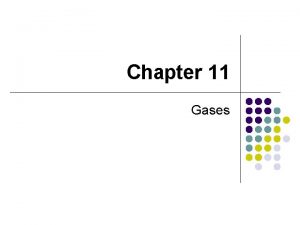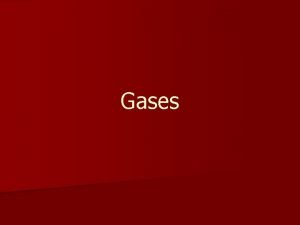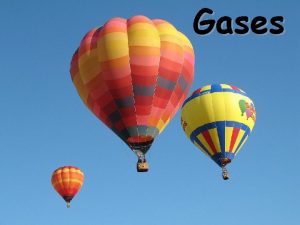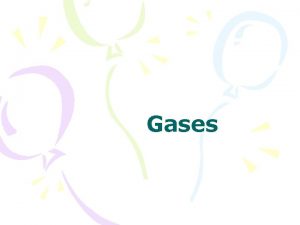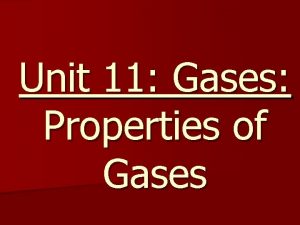Factors that affect gases GASES Factors that affect











- Slides: 11

Factors that affect gases GASES

Factors that affect gases � Pressure �Force exerted when particles collide with their container � Volume �Amount of space or size of the container � Temperature �Average kinetic energy or “speed” of the particles � Moles �Amount or number of particles

Relationships � All of the factors interact and are dependent on each other � When you change one factor, it changes another factor.

Pressure Relationships � What happens to the number of collisions if you increase the size of the container? �(speed and number are constant) � What happens to the number of collisions if you increase the speed of the particles? �(size and number are constant) � What happens to the number of collisions if you add more particles? �(size and speed are constant)

Volume Relationships Imagine the container is a balloon… � What happens to the size of a container if the particles speed up? �(collisions and number are constant) � What happens to the size of a container if you add more particles? �(collisions and speed are constant)

Temperature Relationships � What happens to the speed of the particles if you add more particles? �(collisions and size are constant)

Gas Laws show relationships � Boyle’s Law – Pressure and Volume �P 1 V 1 = P 2 V 2 �Inverse relationship – one goes up, other goes down � Charles’ Law – Volume and Temperature �V 1 / T 1 = V 2 / T 2 �Direct relationship – one goes up, other goes up

Gas Laws show relationships � Gay-Lussac’s Law – Pressure and Temperature �P 1 / T 1 = P 2 / T 2 �Direct relationship – one goes up, other goes up � Avagadro’s Law – Volume and moles �V 1 / n 1 = V 2 / n 2 �Direct relationship – one goes up, other goes up

Gas Laws show relationships These are in your Reference Tables. � Combined Gas Law – Pressure, Volume, and Temperature �P 1 V 1 = P 2 V 2 T 1 T 2 � Ideal Gas Law �P 1 V 1 = P 2 V 2 T 1 n 1 T 2 n 2 or PV = n. RT R is the Universal Gas Constant

Mixtures of Gases � Dalton’s Law of Partial Pressures �Total pressure is equal to the sum of the parts �PT = P 1 + P 2 + P 3 + … � Most often used when gases are collected over water… �Gas’s pressure + Vapor Pressure of Water = Pressure reading

Rate of Effusion � Effusion is the escape of a fluid through a small opening � Graham’s Law of Effusion states that the rate of effusion is inversely proportional to the square root of the molar mass. R 1 / R 2 = √(MM 2) / √(MM 1)
 Walmart thất bại ở nhật
Walmart thất bại ở nhật Gây tê cơ vuông thắt lưng
Gây tê cơ vuông thắt lưng Premature atrial contraction
Premature atrial contraction Tìm vết của đường thẳng
Tìm vết của đường thẳng Sau thất bại ở hồ điển triệt
Sau thất bại ở hồ điển triệt Thơ thất ngôn tứ tuyệt đường luật
Thơ thất ngôn tứ tuyệt đường luật Con hãy đưa tay khi thấy người vấp ngã
Con hãy đưa tay khi thấy người vấp ngã Thơ thất ngôn tứ tuyệt đường luật
Thơ thất ngôn tứ tuyệt đường luật Tôn thất thuyết là ai
Tôn thất thuyết là ai Phân độ lown
Phân độ lown What are the five factors that affect climate?
What are the five factors that affect climate? Factors affecting climate
Factors affecting climate















